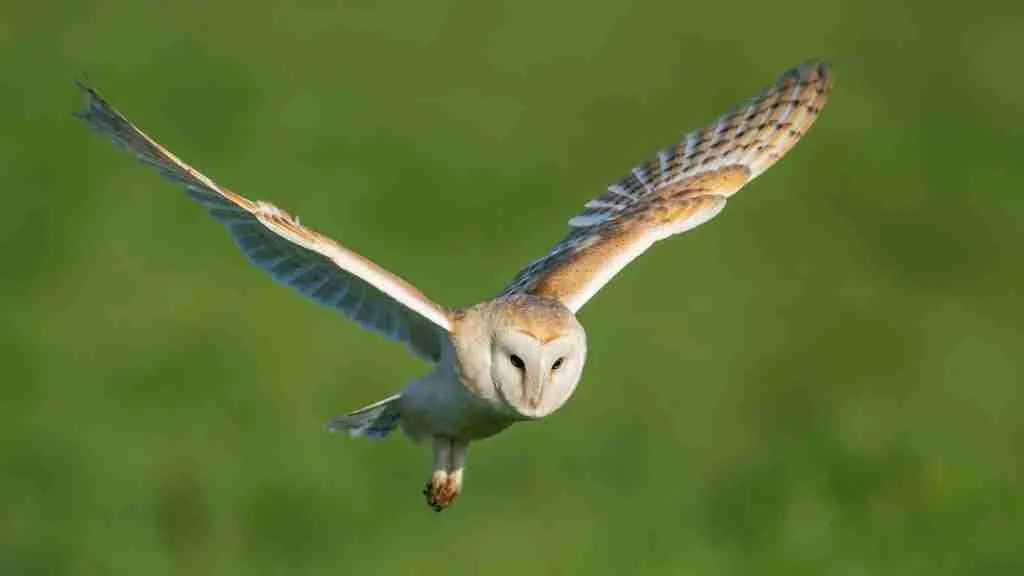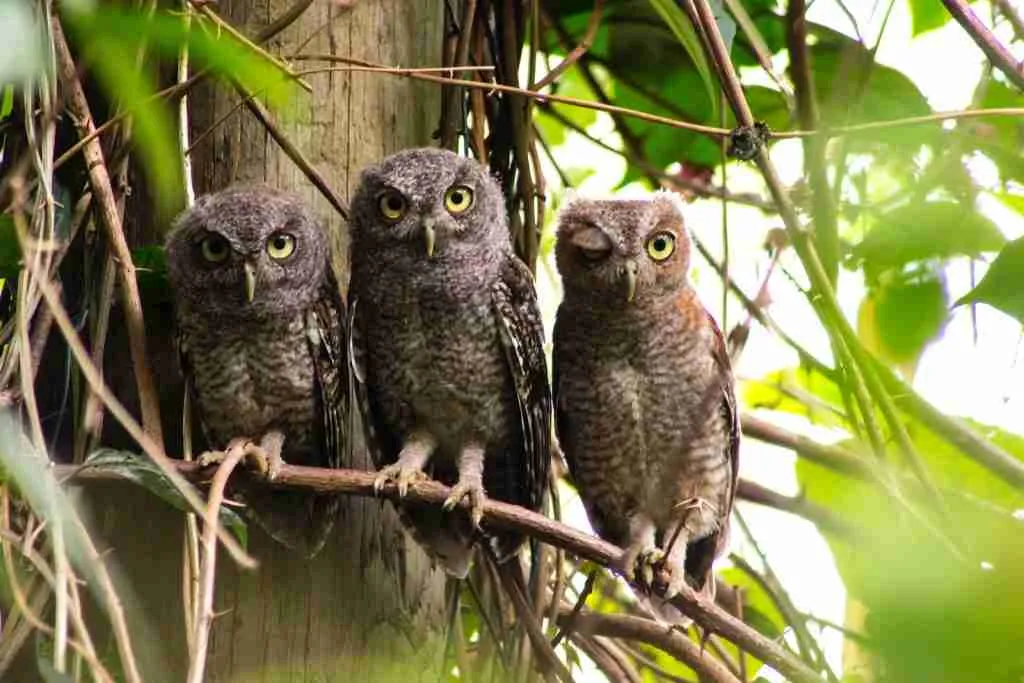17 Fun Facts About Owls You Didn’t Know
-
Most owl species are nocturnal, using the night to hunt and navigate.
-
Their feathers allow them to fly silently, avoiding detection by prey.
-
Some owls, like the Barn Owl, can hunt in total darkness.
-
Owls can eat prey larger than their heads, thanks to their stretchy beaks.
-
They have specialized feathers on their feet for grasping prey securely.
-
Owls’ eyes are so large they take up most of their skull’s space.
-
The Snowy Owl is known for its ability to fly in extreme cold temperatures.
-
Owls can make no sound at all when flying, thanks to unique wing feathers.
-
Some owls can hear a mouse’s heartbeat from over 10 feet away.
-
The Great Horned Owl has the strongest talons relative to its size.
-
Owls can see well in low-light conditions thanks to their large corneas.
-
An owl’s facial disc helps it capture sound from all directions.
-
Some owls will bury prey to eat later when food is scarce.
-
The Long-eared Owl’s feathers look like branches to help with camouflage.
-
Great Gray Owls can hunt by simply hearing the movement of prey.
Table of Contents
1. Owls’ Ability to Rotate Their Heads an Incredible 270 Degrees.
Owls have the unique ability to rotate their heads an incredible 270 degrees. This is due to their specialized neck structure, which has 14 vertebrae instead of the usual 7 found in most birds.
Their flexible necks allow them to survey their surroundings without moving their bodies, a crucial skill for hunting and staying aware of predators.
2. The Incredible Vision of Owls in Near Darkness.
Owls have excellent vision, especially in low light, which is perfect for their nocturnal lifestyle. Their large eyes are adapted to gather as much light as possible, enhancing their ability to see in the dark.
These eyes are fixed in their sockets, meaning that owls must turn their entire head to look around. However, they can still see in near-complete darkness due to their enhanced retina.
3. Owls Have Exceptional Hearing.
Owls possess extraordinary hearing abilities that allow them to detect sounds in complete darkness. Their ears are asymmetrical, with one ear higher than the other, helping them pinpoint the direction of sounds.
This special ear arrangement gives owls the ability to detect the faintest sounds, helping them locate prey even when it’s buried beneath the snow or hidden in thick foliage.
4. The Nocturnal Hunting Habits of Owls.
Owls are primarily nocturnal creatures, which means they hunt at night when their prey is most vulnerable. They rely on their heightened senses, including sharp hearing and excellent night vision, to locate food.
Their night hunting abilities also help them avoid competition from other predators, making them more efficient hunters in the dark hours of the day.
5. The beak of the owl helps to eat and tear its prey.
The beak of an owl is short, curved, and downward-facing. Usually, at the tip, the upper beak is hooked.
Having a small beak helps the owl to have an excellent hearing because it doesn’t block any sound waves from reaching the owl’s ears.
6. The Specialized Feathers of Owls for Silent Flight.
The feathers of an owl are uniquely adapted for silent flight. They have soft, velvety surfaces that reduce sound, and their primary feathers have a serrated edge that further helps muffle sound.
Additionally, their feathers are designed to trap air, reducing the turbulence caused by flight, which allows them to swoop in silently on their prey.

READ ALSO: 27 Facts About Termites You Never know
7. The Lifespan of Owls in the Wild and in Captivity.
While the average lifespan of an owl in the wild is around 5 to 10 years, some species of owls can live much longer in captivity. Barn owls, for example, have been known to live up to 25 years.
This long lifespan allows owls to contribute to their ecosystems for many years, preying on small mammals and helping to control populations of rodents.
8. The Power of Owls’ Talons for Catching Prey.
Owls possess strong, sharp talons that help them capture and kill their prey. These talons are designed to grip and kill small mammals, birds, and even insects.
Their powerful talons are used to pierce the bodies of their prey, holding them in place until the owl can begin to feed. These talons also help owls carry their prey to a safe spot to eat.
9. The Ability of Some Owls to Mimic Sounds.
Certain owl species are capable of mimicking sounds they hear in their environment. For example, the Eastern Screech Owl can mimic the calls of other birds and animals.
This mimicking behavior might help them confuse potential threats or attract mates, adding another layer to the owl’s complex behavioral patterns.
READ ALSO: 25 Fun Facts About Swans That Will Blow Your Mind
10. The Monogamous Habits of Some Owl Species.
Many owl species are monogamous, meaning they mate for life. Once an owl finds a mate, they will often stay together, raising several generations of owls in the same area.
Monogamy helps ensure the survival of the species, as both parents work together to protect and care for their young.
11. Sounds allow the owl to communicate.
We are here to give information about owls, and Facts About Owls for Kids cannot be complete without talking about the signature sound of owls. Owls often make a loud hoot sound.
Not every owl hoots but these birds can make other sounds like whistles, chirps, screeches, and more. Different sounds mean different things e-g hoot is used to claim a territory.
12. Discovering the Diversity of Owls and 250 Species They Belong to.
The owl species can be broken down into two families. The families are Tytonidae commonly known as Barn Owl and Strigidae, which are commonly referred to as true or typical owls. Most owls are true owls. The Barn-owl family has only 20 species.
READ ALSO: 25 Facts About Dogs You Never Knew
13. The Unique Way Owls Digest Their Food.
Owls have a unique method of digesting their food that involves regurgitating pellets. These pellets contain undigested parts of their food, such as bones and fur.
This regurgitation process helps owls clear their digestive systems, ensuring that they don’t retain any unnecessary waste and can continue to hunt effectively.
14. The Owls’ Incredible Adaptability to Different Environments.
Owls can adapt to a wide variety of environments, from dense forests to open grasslands. Their ability to thrive in so many different habitats speaks to their versatility as predators.
Whether in urban areas or rural farmlands, owls have managed to adjust their hunting techniques to suit their surroundings, allowing them to survive in many ecosystems.
15. The Fascinating Way Owls Hunt Multiple Prey Species.
Owls are capable of hunting a variety of prey, from rodents and birds to insects. Their adaptability allows them to adjust their hunting techniques to target different types of prey.
This wide range of dietary preferences ensures that owls can survive in a variety of environments, even when certain food sources are scarce or seasonal.
16. Diurnal owls have different hunting tactics than that nocturnal owls.

READ ALSO: 24 Beautiful Facts About Butterflies You Didn’t Know
Diurnal owls have different hunting tactics than that nocturnal owls, who hide and wait for their prey. Diurnal owls are active hunters. They quietly hunt for prey by flying slowly and low to the ground during the day.
They swoop down and seize their prey as soon as they detect it.
17. The mating season of owls.
The owls get ready for mating after the male owl finds a territory and sings to gain the attention of a female.
If a female thinks the male’s territory is a good place to raise their babies, she will join the male owl. During their breeding, the pair of owls sing, to let the other owls know that they are mating and don’t need a partner.
READ ALSO: 25 Fun Facts About Cats You Didn’t Know
18. The male owl is responsible for food and the female owl provides security to newly hatched chicks.
The female owl stays at the nest after she lays the eggs to guard the eggs and chicks. the male owl will go hunting and bring food back to the nest.
Eventually, the young chicks grow, and the male cannot feed them alone, so his partner joins him in the hunt.
19. Separating Myth from Reality and the Symbolism Surrounding Them.
The symbols and mythology associated with owls are numerous. For instance, owls are revered in Western cultures as knowledgeable animals.
This goes back to the time of Ancient Greece when the owl was the emblem of Athena, the goddess of wisdom.
20. The Importance of Owls in Cultural Folklore.
Owls have long been symbols of wisdom and mystery in many cultures around the world. From Ancient Greece to Native American tribes, owls have been portrayed as mystical creatures with deep knowledge.
Their enigmatic appearance and nocturnal habits have led to their association with wisdom, protection, and even magic in various cultural myths and legends.
FAQS
Owls are unique for their silent flight, exceptional night vision, and powerful talons. Their specialized feathers, large eyes, and acute hearing help them hunt effectively at night. These adaptations make them remarkable nocturnal predators.
Owls have long been symbols of mystery due to their nocturnal habits and eerie calls. Their ability to silently hunt in the dark, along with their haunting appearance, has made them the subject of many myths and legends across cultures.
Owls primarily eat small mammals like mice, rats, and rabbits, but they also hunt birds and insects.
They can be found in a variety of habitats, including forests, grasslands, deserts, and even urban areas. Some species adapt to live in cities or near farmlands.
The scientific name for the owl varies by species. However, the general order for owls is Strigiformes. Barn owls, for example, are scientifically known as Tyto alba, while typical owls belong to the family Strigidae.
While owls are not generally dangerous to humans, they are fierce hunters. Their talons and beaks are powerful enough to catch and kill small prey. However, they will not attack humans unless provoked or cornered.
Owls have exceptional hearing and vision, allowing them to hunt effectively in the dark. Their ability to rotate their heads up to 270 degrees helps them survey their surroundings. Additionally, their silent flight and powerful talons make them efficient predators.





